NASA’s Perseverance rover is providing us with amazing new views of its home.
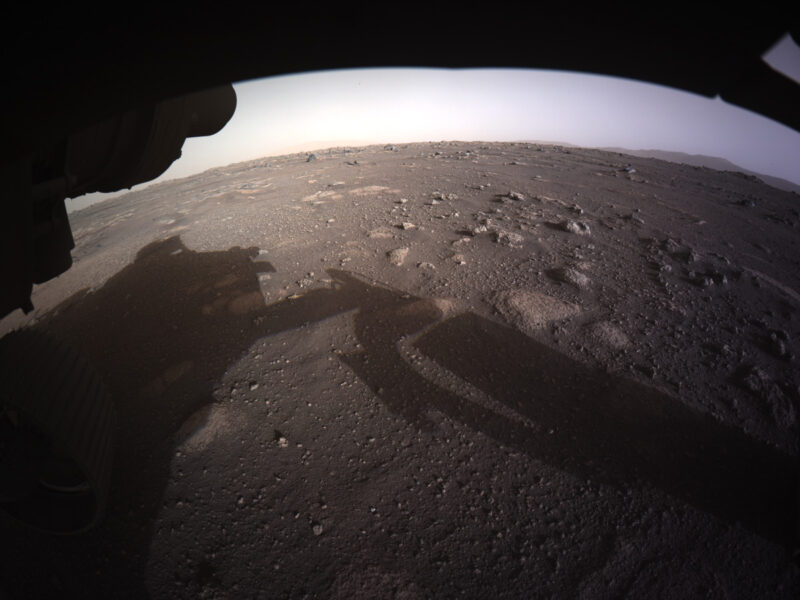
NASA / JPL-Caltech
After an amazing sky-hook landing in Jezero Crater on Mars, Perseverance is waking up and beginning to explore its new alien home.
"For those who wonder how you land on Mars — or why it is so difficult — or how cool it would be to do so — you need look no further," says acting NASA administrator Steve Jurczyk. "Perseverance is just getting started, and already has provided some of the most iconic visuals in space exploration history."
The pinpoint landing for Perseverance on Jezero’s floor occurred on February 18th at 3:44 p.m. EST (20:44 UT). This marks NASA’s second successful sky-crane landing on Mars following Curiosity’s touchdown in 2012.
The news of the landing traversed the 11 light-minute distance from Mars to Earth, relayed via the Mars Reconnaissance Orbiter (MRO) and the Mars Atmosphere and Volatile Evolution (MAVEN) mission to NASA’s Deep Space Network. In the days thereafter, the European Space Agency's Trace Gas Orbiter and NASA's venerable Mars Odyssey were also invaluable in getting data from Perseverance back to Earth.
In addition to acting as relay, MRO’s onboard camera also captured the landing in action. (MRO snapped a similar image of Curiosity just before its touchdown in 2012.)
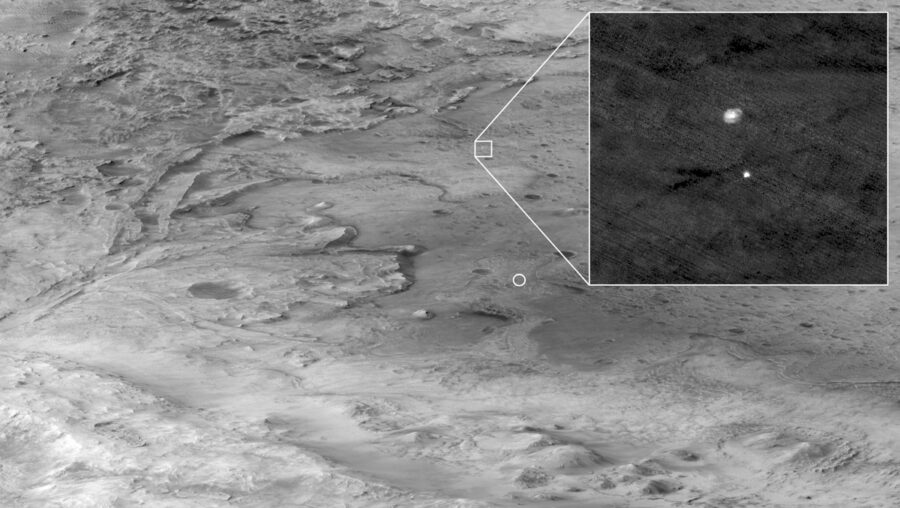
NASA/JPL-Caltech/University of Arizona
MRO also snapped the Perseverance landing zone in Jezero Crater from orbit:
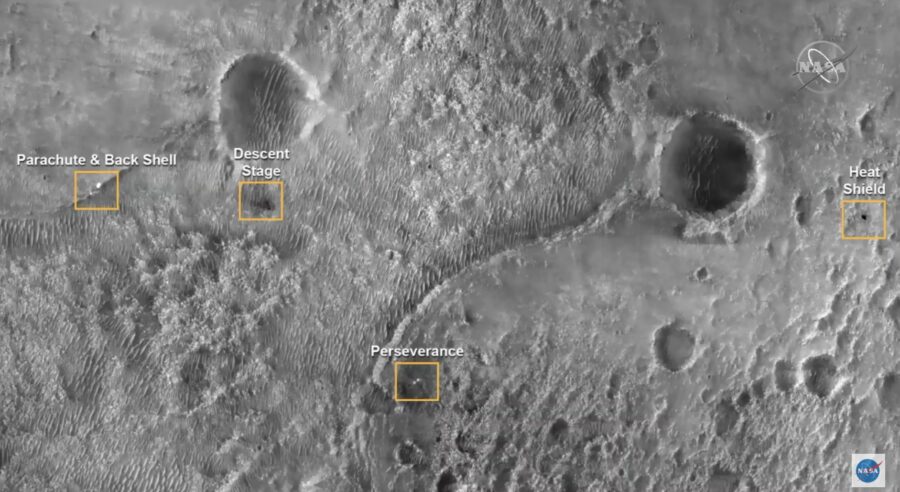
NASA / JPL-Caltech / University of Arizona.
But the best was yet to come. This past weekend, NASA released an amazing image of Perseverance suspended beneath the sky crane, taken from the cameras aboard the descent stage. This hinted at what NASA released today: a full video of the landing.
The views shown in the video below come from a camera looking down from the spacecraft’s descent stage, a camera on the rover looking up at the descent stage, a camera on the top of the aeroshell looking up at the parachute, and a camera on the bottom of the rover looking down at the Martian surface.
Your front-row seat to my Mars landing is here. Watch how we did it.#CountdownToMars pic.twitter.com/Avv13dSVmQ
— NASA's Perseverance Mars Rover (@NASAPersevere) February 22, 2021
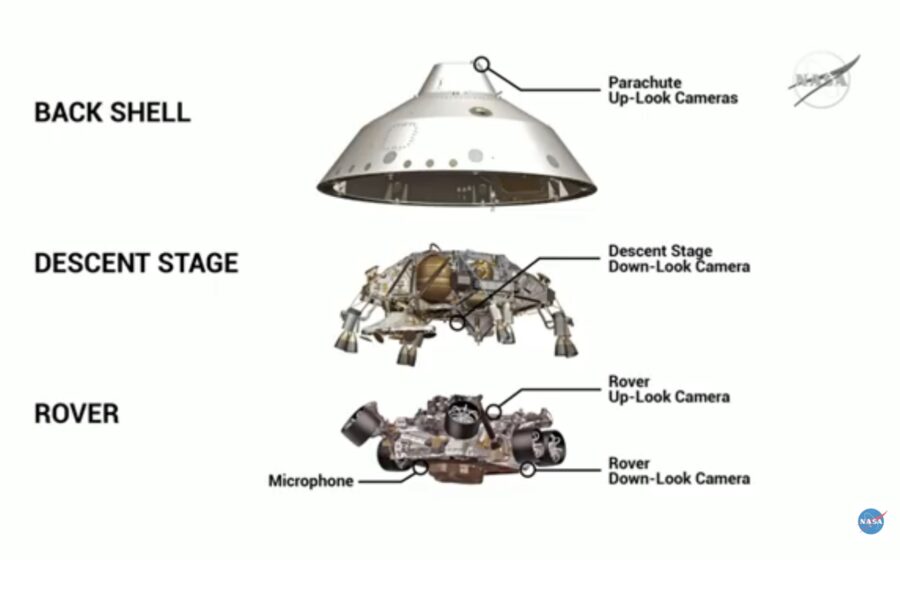
NASA/JPL-Caltech
Safe on the Surface of Mars
The very first shots for Perseverance were low-resolution, black-and-white images from the Hazard Cameras (HazCams) underneath the rover, showing the alien terrain. (Swipe with your mouse or simply move your mobile device mobile to see the full 360° view.)
The team at JPL is now settling into “Mars time” for operations, with a Martian day (called a sol) just 37 minutes longer than Earth’s. Over the past weekend, pyrotechnics were activated to release and deploy the mast, which is equipped with the zoomable Mastcam-Z, the laser instrument known as SuperCam, and another cluster of NavCams.
The raw images also started to trickle in, available on the Perseverance website. Already, we’re seeing Perseverance’s aluminum wheels, ready to kick up some Martian dirt:

NASA/JPL
And the “video” that circulated this past weekend, purporting to include the first sounds from Mars? It’s a hoax. Perseverance does include two microphones however, which did indeed capture the first true sounds recorded on Mars, released by the team today. Perhaps, this just shows how anxious people were for NASA to release updates from Perseverance over the weekend!
Next up, Perseverance will perform several battery charge tests on the Ingenuity helicopter currently berthed on the underside of the rover, bringing up the charge to 30% several times. The rover is plutonium-powered, but Ingenuity will rely on solar power once it’s on its own. The team expects to place Ingenuity down on the surface of Mars in a month or two, in preparation for its first flight. Ingenuity’s initial sortie will represent the first flight of a helicopter (or any kind of powered aircraft) on another world.
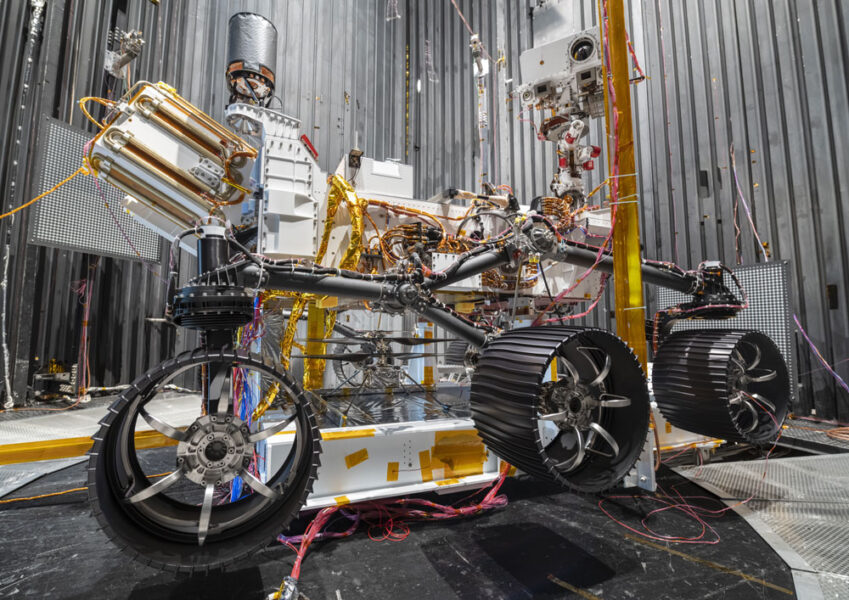
NASA / JPL-Caltech
Perseverance is the first mission to explicitly address the question of whether life once existed on Mars, and the ancient flood plain in Jezero is an ideal site to begin the search. Watch for Perseverance to flex its robotic arm and perform its first short test drive in the coming weeks. During its year-long nominal mission (that’s a Mars year: 668 sols or 687 Earth days), Perseverance will collect and cache samples of Martian regolith. In the coming years, a sample-return mission will arrive on Mars to collect those samples.
If Perseverance survives over the next decade or so (a distinct possibility, with its nuclear power source), it might just witness the next landing on Mars: a sample return spacecraft, which would touchdown nearby.
 3
3









Comments
Andrew James
February 22, 2021 at 5:07 pm
See this in HD is just extraordinary. Worried about the amount of fine dust and the sand traps. Might be a shorter mission than we think.
You must be logged in to post a comment.
Robert-McCabe
February 23, 2021 at 11:15 am
I was also wondering about how firm the ground is there. It is an old delta, full of fines. Hope it doesn't get stuck in there!
You must be logged in to post a comment.
Yaron Sheffer
March 3, 2021 at 1:00 pm
When Monica wrote two weeks ago about Perseverance having 23 cameras, I just knew it that NASA would use at least 22 of those for selfies 🙂
You must be logged in to post a comment.
You must be logged in to post a comment.